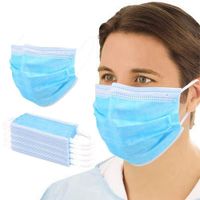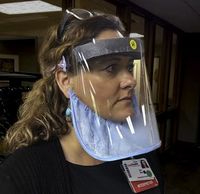Draft:Teaching and face coverings
| FREQUENT UPDATES: This article contains guidance related to COVID-19 that is subject to change. Check the COVID-19 Response at WSU site for the latest information and direct all questions about this article to TLT (tlt@winona.edu). |
Research indicates that face coverings, combined with physical distancing, reduce the transmission of COVID-19 significantly. In accordance with WSU's decision on August 4th, 2021, all Winona State University students are required to wear approved face coverings during in-person class meetings until further notice. Instructors have the option of removing their face covering if they can maintain a six-foot distance between themselves and their students. Instructors can teach with face coverings effectively with some prior planning. Ultimately, the use of face coverings while teaching is a matter of public health. As uncomfortable as this might be for you individually, we are all doing this to keep our community safe.
Approved face coverings
Approved face coverings include a paper or disposable mask, a cloth face mask, a scarf or bandanna, or a religious face covering. Your face covering, "should cover the nose and mouth completely, should not be overly tight or restrictive, and should feel comfortable to wear."
University-supplied face coverings
Disposable masks
Facilities (facilities@winona.edu) maintains a supply of surgical-style, disposable masks, and will stock various campus locations this fall, including all classrooms and the main entryways of all campus buildings. Every classroom will include a sanitization kit with spare disposable masks for those who need them.
Reusable branded cloth masks
Every Winona State University student and employee will receive one branded cloth mask prior to the start of the fall semester. Contact TLT (tlt@winona.edu) if you are interested in ordering additional branded cloth masks.
Reusable branded clear masks
Clear masks are cloth masks with a transparent window over your mouth and can be helpful in situations where seeing your lip movements and facial expressions facilitate understanding. Contact TLT (tlt@winona.edu) if you would like a clear mask.
Face shields
A transparent face shield can be worn along with a mask if additional protection is required. Instructors can also choose to don a face shield when removing their mask temporarily while teaching. Contact TLT (tlt@winona.edu) to request a face shield. For optimal protection, the face shield should extend below the chin anteriorly, to the ears laterally, and there should be no exposed gap between the forehead and the shield’s headpiece. Two types of face shields are available:
Standard face shield
This type of face shield is recommended for use along with a face covering when additional protection is required.
Face shield with fabric enclosure
This type of face shield is recommended when removing your face mask temporarily in classrooms where a six-foot distance can be maintained between the instructor and students.
Personal face coverings
Employees are welcome to wear face coverings other than those supplied by the university. They should be made of at least two layers of fabric, cover the nose and mouth without gaps.
Removing a face covering temporarily while teaching
Current MDH guidelines suggest that teachers can safely remove their mask while teaching under the following conditions:
- If a six-foot distance can be maintained between themselves and their students. A face shield may also be used as an alternative to a face covering under this condition
- During indoor practices or performances involving singing, acting, or playing musical instruments where face coverings cannot be worn or are impractical to wear while playing the instrument or participating in the activity. Because these activities often generate aerosols, performers should maintain at least 6 feet of physical distance from each other, but should ideally maintain greater distance (e.g., 12 feet) when possible. Performers should be separated from audience members by a distance of at least 12 feet before removing their face coverings. Depending on the activity, face shields or face coverings designed specifically for the instrument or activity (e.g., face coverings designed specifically for brass and woodwinds) should also be considered as an alternative if social distancing cannot be consistently maintained.
- Face coverings may be temporarily removed to eat or drink, but care should be taken to maintain as much space as possible between people, recognizing it is not always feasible to maintain 6 feet of distance from others.
- When communicating with a person who is deaf or hard of hearing or has a disability, medical condition, or mental health condition that makes communication with a face covering difficult, provided that social distancing is maintained to the extent possible. In these situations, a transparent, physical barrier (e.g., plexiglass) may be considered as an additional mitigation strategy.
Voice amplification
If you require voice amplification in any campus learning space, including outdoors, please contact TLT (tlt@winona.edu) to discuss options and schedule support. The use of a properly-fitted, approved face covering should not affect the audibility of your voice significantly. The use of tightly-fitted N95 or respirator-style masks (e.g., P100) may affect voice audibility.
More wiki articles
- Live online access to in-person class meetings
- Using a document camera in a Zoom meeting
- In-person COVID Toolkit
External links
Except where otherwise noted, text is available under the Creative Commons Attribution-NonCommercial-ShareAlike 4.0 International License.




